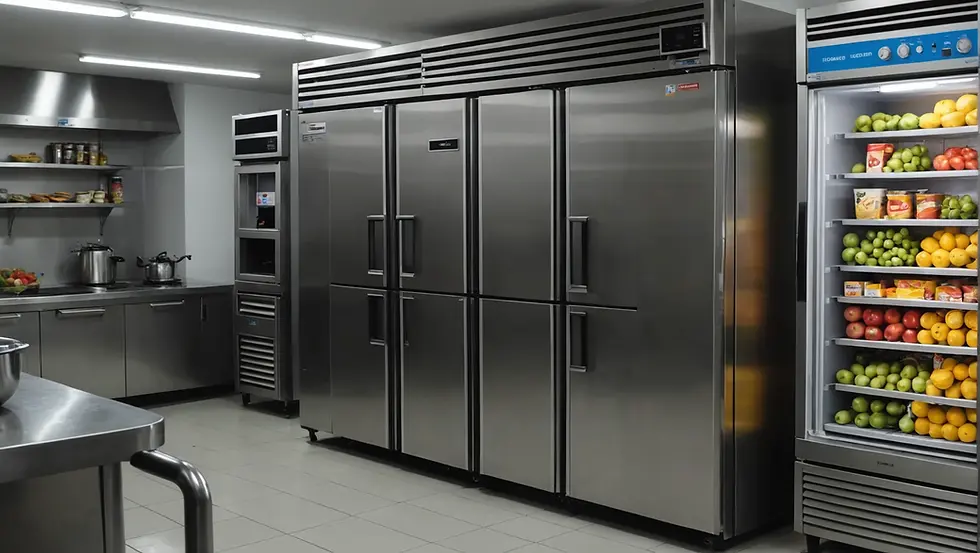Revolutionize Your Kitchen: Uncover the Top 5 Secrets to Tackle Food Waste and Skyrocket Your Restaurant's Success!
- Tulasidas Tummala

- Nov 11, 2024
- 3 min read
Food waste is a pressing issue in commercial kitchens. It affects not only the environment but also the financial health of restaurants. With sustainability becoming a necessity rather than just a nice-to-have, it’s crucial for restaurants to adopt effective waste-minimizing practices. Reducing food waste isn't only about being eco-friendly; it can also lead to increased profits. Ready to transform your kitchen? Here are five actionable strategies to help you minimize food waste and enhance your restaurant's success.

1. Smart Inventory Management and Monitoring
Over-ordering and poor inventory management are two top contributors to food waste. Implementing a robust inventory tracking system can help you save money and reduce waste. For example, restaurants that use inventory systems that monitor stock levels in real-time can cut food waste by as much as 15% according to a study by the Food Waste Reduction Alliance.
To further optimize your inventory, consider using a First In, First Out (FIFO) method. This involves using older stock before newer items, which can reduce spoilage and keep your operations smooth. You might want to explore specific software solutions that send alerts when stock is low or nearing expiration.
Pro Tip: Conduct monthly inventory checks and analyze your purchasing patterns to avoid overstocking on items you use infrequently.
2. Portion Control and Menu Optimization
It’s essential to analyze your menu to pinpoint which dishes often result in leftovers. By adjusting portion sizes based on actual customer consumption, you can significantly reduce waste. If you notice that a specific dish consistently leaves diners with half-plates, lowering the portion size could be beneficial.
Additionally, think about optimizing your menu to feature dishes that use similar ingredients, which can prevent items from going to waste. For instance, if you focus on three dishes that all use seasonal vegetables, you will not only streamline your ingredient supply but also ensure each item is effectively utilized before spoiling.

Expert Recommendation: Consider offering adjustable portion sizes to your customers. This allows diners to choose what works for them—ultimately reducing leftovers.
3. Composting and Recycling Initiatives
Sustainability is more than just a trend; it’s an essential practice. By partnering with local composting programs or setting up your own in-house composting system, you can significantly cut down on landfill waste. Studies show that composting can lead to a 30% reduction in organic waste, benefiting both the earth and your restaurant’s image.
Be sure to communicate your sustainability efforts to your customers. Create signage to educate diners about your composting initiatives or share your efforts on social media. This not only shows your commitment but also can attract eco-conscious patrons who appreciate sustainable practices.
Pro Tip: Offer incentives for customers who participate in your recycling and composting programs, like discounts on future purchases.
4. Training Staff and Fostering a Culture of Waste Reduction
Creating a culture that prioritizes minimizing food waste starts with an educated team. Schedule regular workshops to inform your staff about the importance of waste reduction. Teach them proper food storage techniques and encourage resourcefulness.
Challenge your team to come up with creative ways to repurpose leftovers. For instance, vegetable scraps can be transformed into flavorful stocks, and stale bread can be made into croutons. When staff members are invested in sustainability efforts, it boosts morale and teamwork.
Expert Suggestion: Implement an employee-led waste audit every month to track waste levels, empowering staff to brainstorm new strategies for reduction.
5. Collaborate with Local Suppliers and Producers
Forming strong relationships with local suppliers enhances your restaurant's sustainability. By sourcing ingredients in smaller quantities and on an as-needed basis, you can avoid over-purchasing. Studies indicate that local produce can lead to a 20% reduction in food waste due to fresher ingredients with longer shelf lives.
Don’t stop at food suppliers. Collaborate with other local businesses to find innovative solutions for reducing waste. You might discover joint initiatives that can make a significant impact—perhaps even sharing excess supplies or processing items together.
Pro Tip: Organize a monthly local supplier fair featuring your partners. This not only strengthens relationships but also showcases your community ties to your customers.
Taking Action on Food Waste Reduction
Addressing food waste is crucial for both environmental sustainability and restaurant profitability. By implementing effective strategies such as smart inventory management, portion control, composting, staff training, and local supplier collaborations, you can markedly reduce waste while improving operational efficiency.
Start your journey toward minimal food waste today. Embrace these strategies for the betterment of both the planet and the success of your restaurant. Every small change adds up, paving the way for a thriving hospitality industry focused on sustainability. Together, we can turn the tide on food waste and drive substantial change for a brighter future!
At Veecos Canteen Equipments, we believe in sustainable solutions for commercial kitchens. From inventory management tools to efficient equipment, we provide the products and insights you need to minimize food waste and maximize profitability.




Comments